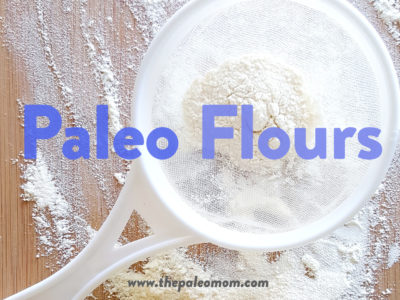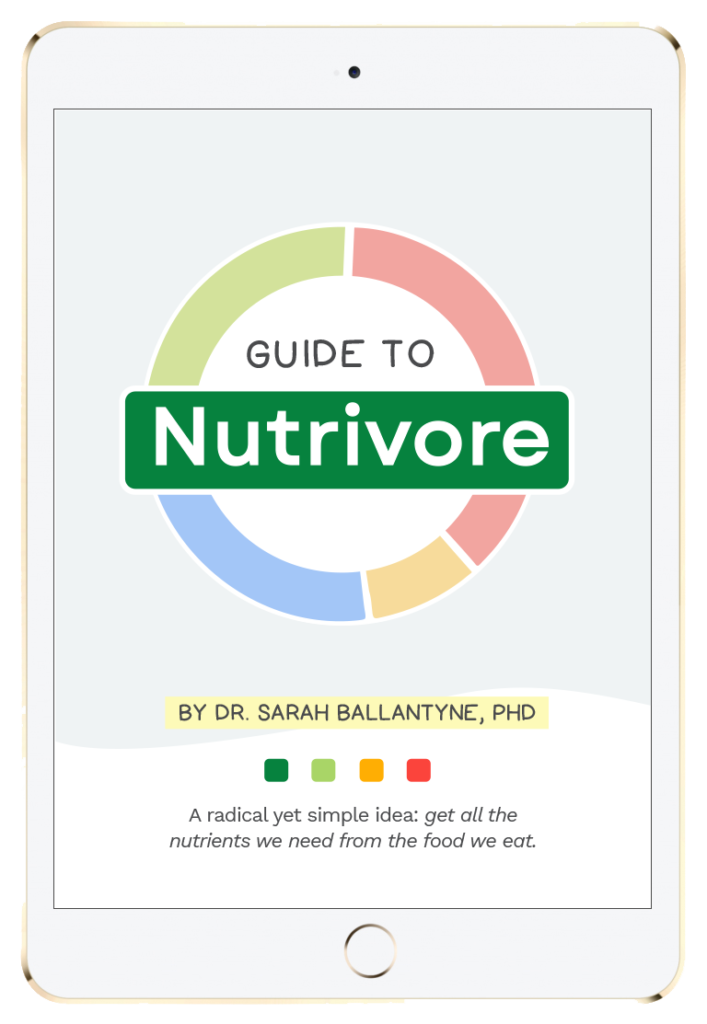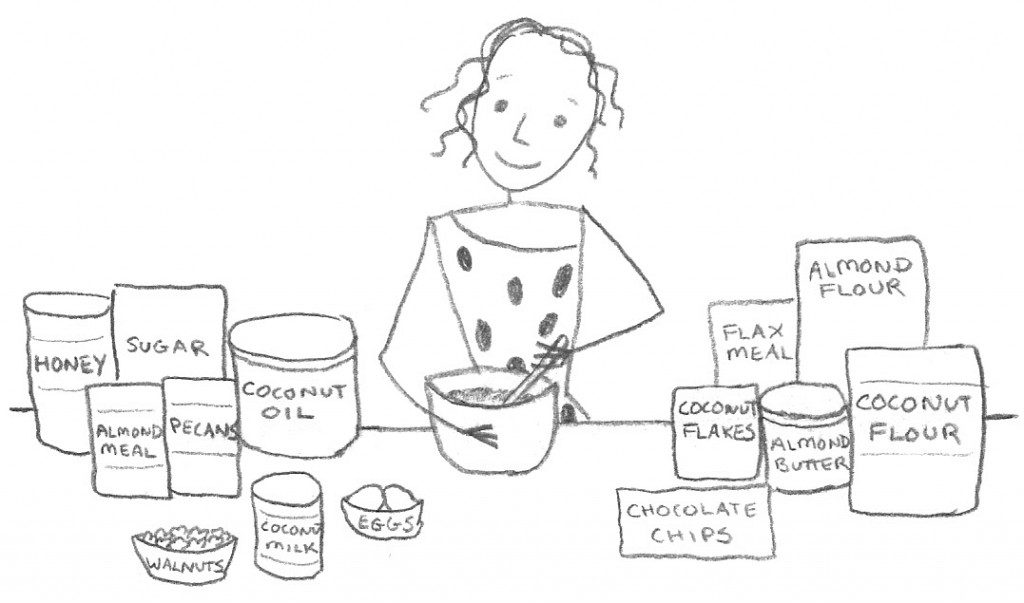Paleofying is often used as a derogatory term to describe the process of adapting Neolithic foods, typically desserts and sweet treats, to use only Paleo-approved ingredients. While some people look down on this practice as not addressing the problems of excess carbohydrate consumption and food addiction, I look at it as an important tool—it is a powerful strategy for making Paleo accessible and sustainable for the general public. Eating a restricted diet is much easier when you feel like you can still have birthday cake, can still celebrate a job promotion with a special dessert, can still bring cookies to your kid’s bake sale, can still make pancakes for Sunday brunch, and generally still get to eat delicious foods. Paleofied baked goods mean that having a treat won’t damage your gut, cause rampant inflammation, or create a cycle of food cravings. I like the word Paleofy. To me, this represents the union of nutrient-rich, anti-inflammatory “old” foods and modern life.
As we start the lead up to the holiday season, many of us are looking at conventional holiday baked good recipes and wondering how easy those recipes would be to adapt to Paleo ingredients. Yep, I’m doing this too. Whether these are family favorites or recipes that just look delicious off of pinterest or in magazines, the first step to paelofying is deciding what recipe to start with. Gluten-free recipes are often a great place to start, as long as the recipe don’t rely too heavily on xanthum gum to hold it together. Other recipes that are often good bets too are those that use cake flour, use at least a couple of eggs, have dried fruit, have fruit or vegetable purees, have liquid sweeteners (like honey), or that have fairly large amounts of fat in them.
Paleofying is as much an art as it is a science. I vaguely remember a time when I did not have extremely well-honed cooking instincts (I think that was back in middle school). But even starting out as a fairly good cook, there was a steep learning curve to all of these new ingredients and to baking without gluten. After a year of Paleo baking (and blogging!), I have a much better understanding of how to adapt conventional recipes now and thought it was high time I share some of this knowledge and experience with you, in addition to my perfected recipes.
This post is the first in a 4-post series. In this post, I will discuss Paleo flours and other ingredients that add bulk to a recipe. Part 2 of this series will discuss binders (ingredients that hold baking together). Part 3 will discuss leavening agents and sweeteners. Part 4 will discuss some strategies for doing iterations and troubleshooting your recipes. You may also be interested in some of my posts that reference Paleo baking ingredients: Important Pantry Items for The Paleo Baker, Paleo Flour Substitutes, Sugar vs. Sweeteners, and Is Sugar Paleo?).
I am continuing to expand my Paleo baking tool kit by playing with new ingredients. Below is a list of all the Paleo flour substitutes I can think of and other ingredients that add bulk to a recipe. Some of these are still fairly new to me, so I still have fairly limited experience with them. Which flour substitute(s) you choose really depends on the type of recipe and what the texture of the finished product should be. I will try and give you enough information to help get you started.
Blanched Almond Flour—This is the stereotypical Paleo flour substitute. A high quality blanched almond flour (like Honeyville Farms or JK Gourmet) is very finely milled and can be quite light compared to other nut and seed flours or even a less finely milled almond flour (like Bob’s Red Mill, which I consider and almond meal). Generally, it measures 1:1 when substituting for wheat flour. It works very well in baking where you want a denser crumb, like muffins, coffee cakes and chewy cookies. In recipes that also have a fairly large amount of wet ingredients, adding a starch or coconut flour can be helpful.
Almond Meal—This is a less finely ground version of blanched almond flour. It typically uses the whole almond (like NaturAlmond, Trader Joe’s or Honeyville Farms) but some blanched almond flours (like Bob’s Red Mill) actually qualify more as a meal than a flour. This is best for breading meat, but also can be used for dense baking like dense cakes (e.g. fruit cake), some cookie recipes and pie crusts. If you are using almond meal in place of almond flour in a recipe, use slightly less as it tends to be denser.
Coconut Flour—This flour has a very high fiber content and absorbs liquid very efficiently, so it is really only used in recipes that have a large amount of wet ingredients. Because it makes for a finer crumb than nut flours, I like coconut flour for cake and cupcake recipes. It is also good for shortbread style cookies. This is a very tricky flour to work with; often 1tsp can make the difference between the texture you are going for and something completely different. When doing iterations with recipes that use coconut flour, always make small changes to the amount of flour used. Always sift coconut flour before adding to your recipe, unless you are blending your batter in a blender or food processor. When you add coconut flour to wet ingredients, the batter will thicken as it sits for the first few minutes. It’s always a good idea to give your batter time to thicken before putting it in the oven. The general rule of thumb is to replace wheat flour with ¼ the amount of coconut flour. This will be sufficient for some recipes; but if you need to bulk up your dry ingredients, you can then add some nut or seed flours to bring the volume up a little (a good place to start is with the same volume you are using of coconut flour). Different coconut flour brands do behave slightly differently depending on how finely they are ground. I typically use Tropical Traditions brand now but I find that Bob’s Red Mill behaves very similarly.
Arrowroot Powder—This is the dehydrated and ground arrowroot tuber (not the cassava root). It is mostly a starch and is great for adding lightness to a recipe (also lovely for thickening sauces). Arrowroot powder can replace corn starch in recipe 1:1. You can also mix arrowroot powder with very finely ground granulated sugar to make an acceptable substitute for icing/confectioner’s sugar. If replacing wheat flour with arrowroot flour to add lightness to a recipe, replacing up to ¼ of your flour with arrowroot is typical. I love using arrowroot in conjunction with coconut flour for cake recipes. It doesn’t add much hold to baking that don’t have much binding ingredients, though. I use arrowroot powder frequently enough that I actually use the Subscribe&Save program from amazon to have it automatically shipped to me.
Tapioca Starch—This starch comes from the ground cassava (a.k.a. yucca, yuca, manioc, tapioca) root. This is not the same as arrowroot powder. Even though many people use tapioca and arrowroot interchangeably, they actually have fairly different properties in baking. Tapioca adds elasticity to baking, helping bind as well as giving more bounce (the cassava root is naturally a very slimy starch). Tapioca nice to use in Paleo bread recipes and can be useful in cake recipes as well to give a little more bounce to the baking. You can replace up to about half of the flour normally called for in a recipe with tapioca (some gluten-free baking replaces all of the flour with tapioca, but tapioca is probably the least healthy of the Paleo flours, so I don’t recommend this). Tapioca also isn’t a very good substitute for corn starch, but would do in a pinch.
Most Paleo baking you will find on my site and others use various combinations of the above four flours. But, these aren’t the only Paleo flours out there and there are some really great less-frequently used options to consider.
Plantain Flour—Plantain flour is quickly becoming one of my favorite flours to work with, although I am still experimenting with it. It is simply ground dehydrated plantain. It does have a distinct plantain taste so it doesn’t work in all baking. It has a lovely ability to bind (similar to tapioca starch, but with more of a wheat flour like texture and crumb) and generally can be substitute wheat flour 1:1. It seems to work very well in soft, cakey and/or chewy baking recipes and not as well if you want some crunch or crispness. A word of caution. Some flour are labeled as plantain flour but actually contain a mix of different tubers, often containing potato starch in addition to plantain flour. If you are buying this from a store, make sure to check the ingredients label. I buy Barry Farm plantain flour from amazon.
Nutrivore Weekly Serving Matrix
An easy-to-use and flexible weekly checklist
to help you maximize nutrient-density.
The Weekly Serving Matrix is very helpful! I’ve been eating along these lines but this really helps me know where to focus vs. which foods serve a more secondary role. It’s super helpful and has taken a lot of worry out of my meal planning. Thanks!
Jan
Sweet Potato Starch—This is sometimes labeled as sweet potato flour, but this fine white powder is actually a processed flour/starch. It substitutes well for arrowroot, but has almost no ability to hold baking together. You can use this as a corn starch substitute or in combination with other flours as a flour substitute. I’m not super enthusiastic about this starch, but it’s a good option if arrowroot is hard for you to find.
Sweet Potato Powder—This is also sometimes labeled as sweet potato flour, which can be very confusing. Sweet potato powder is ground dried sweet potatoes and still retains its orange color (sweet potato starch is white). This is a more interesting flour because it has some fiber and can absorb liquid so it has more ability to hold baking together. I have used it in pancakes and have played with it as a flour substitute for brownies. I’m still getting familiar with this flour, but it’s definitely a neat one to play with.
Kuzu Starch—I am just starting to play with kuzu starch (which is ground dehydrated kuzu root, used in Asian cooking). Apparently, it is even better than arrowroot at thickening and I’m hoping that it will be useful to help get a few recipes I’m working on a little firmer in texture.
Sunflower Seed Flour—For those allergic to nuts or just almonds, sunflower seed flour can be used the same as almond flour (it can be a little denser depending on brand, so you might need to pull back the amount somewhat). It has the fun property of turning green when used in baking that also contains baking soda (it’s totally safe to eat when it does this).
Hazelnut Flour—This can also be used the same as almond flour, but yields a different flavor to the baking.
Chestnut Flour—This can also be used the same as almond flour, but yields a different flavor to the baking. It has a more hold than almond flour, which is very handy, so you can easily use this flour on its own in some recipe. It’s also quite a bit sweeter so you may want to reduce the sweet ingredients in your recipe if you are using this.
Pumpkin Seed Flour—This is another seed alternative to almond flour. Pumpkin seed flour measures more closely to almond flour due to its higher protein content. Also has a distinct flavor and slightly green color and is easier to make at home than most other nut flours.
Ground nuts and seeds—Ground nuts and seeds are a wonderful way to add more texture and bulk to making. Many of them can help act as binders as well. Mostly, you’ll be grinding your own in a food processor or blender. A finer grind will act more like a nut flour, but you can also grind more coarsely which replicates the texture of oatmeal or other whole grain ingredients very well. Making a mix of different nuts can replicate the flavor and texture of oatmeal and can help fix texture problems when working on denser baking recipes like cookies and muffins. Ground flax seed also qualifies here as a way to add bulk and texture to baking and is an excellent binder too. Chia seeds are often used similarly to flax seeds but these are a pseudograin, and Prof. Loren Cordain comes down pretty hard on chia in The Paleo Answer. My favorites to use are Whole Almonds, Pecan Halves
, Walnuts Halves
, Macadamia Nuts
, Hazelnuts (Filberts)
, Pistachios
, Cashews
, Brazil Nuts
, Pepitas (hulled pumpkin seeds)
, Sunflower Seeds
, Brown Sesame Seeds
, Black Sesame Seeds
, and ground flax seed (golden or regular, which act the same but just look different). The combination of walnuts, coconut, and pumpkin seeds makes for a fantastic oat-like flavor (see my recipe for Paleo porridge, “oatmeal” cookies, and apple crisp for examples).
Finely Shredded Coconut—This is also a good bulking ingredient, similar to ground nuts and seeds but with a slightly different texture and flavor. Because of the fiber content, it will absorb a little liquid (although nothing like coconut flour), so it does behave slightly differently than other nuts and seeds.
Vegetable Powders—Pumpkin, carrot, spinach, sweet potato, winter squash, red cabbage, and beet powders are all available. I have only used a handful of these in pancake recipes, but I think these are a very fun way to deal with recipes where you want the sweetness and maybe flavor of these vegetables but are struggling with too many wet ingredients. These are also a great way to add natural color to recipes (usually you can use little enough that these contribute color but not flavor).
Pureed Green Plantain—This is my newest secret weapon in Paleo baking. Green plantains are very starchy, have a fairly neutral flavor and can act as a binder and give bulk to a recipe. I have several recipes that use green plantains and many more ideas for this versatile fruit! Check out my Perfect Paleo Pancakes, Paleo Crepes, and Decadent Double Chocolate Cookie recipes for examples. Watch this video from my YouTube Channel to learn more about green plantains. Ripe plantains are another option, but behave quite differently in baking (sweeter, more flavorful, act more as a binder than a flour).
Pureed or Ground Root Vegetables —Don’t underestimate the versatility of canned or pureed root vegetables in your baking. And you aren’t limited to canned pumpkin. Sweet potato, yucca, taro, parsnip, carrot, winter squash, and plantain are all good options (see my recipe for Paleo biscuits for an example). When cooked and pureed, they can both act as a binder and add bulk to a recipe (see my spinach brownies or pumpkin gingerbread muffin recipes as examples). When ground and raw, they have a very different effect on texture (see my carrot parsnip muffins for an example). They also can add some sweetness without the use of sugars and the flavors are often well camouflaged by other ingredients.
So, which one do you use? The classic is to use almond flour on its own or in conjunction with arrowroot, tapioca and/or coconut flour as a first attempt in a recipe. The reason why this is so common is because the ingredients are fairly easy for most people to find and they are fairly predictable in how they will behave in recipes. And while I encourage you to play with the other flour substitute options, to get you started on your Paleofying adventure here is my basic formula for replacing wheat flour with almond, coconut, arrowroot and/or tapioca flours.
- For a recipe without many wet ingredients (like cookies): replace wheat flour with 80-100% almond flour, 0-20% arrowroot or tapioca (depending on whether I want the lightness or the elasticity) and 0-20% coconut flour. Yes, there is a range here. I am more likely to use a starch and coconut flour if the volume of flour is fairly high (almond flour is expensive!).
- For a recipe with substantial wet ingredients (like muffins or cakes): replace wheat flour with 25% nut flour, 25% coconut flour, 25% arrowroot or tapioca (depending on whether I want the lightness or the elasticity). Yes, this doesn’t add up to 100%, which is because of the properties of coconut flour.
- I don’t have a fixed formula for replacing flours when the desired outcome is nut-free. I just wing it.
- These are just my first iterations. Sometimes I change things up as soon as I see the texture and thickness of the batter (that might be harder for you to do if you aren’t used to working with the flours). After I see what the texture and taste is of my first attempt, I either change quantities or try different flours. And of course, as I play with other flour substitutes, this may change, my default formulas are likely to change.
I hope this will get you started on your Paleofying adventures. As you play more and more with these ingredients and get to understand their properties better, it will be easier to intuit what will work in any particular recipe. But, I still have recipes that take me many iterations to get right. And of course, if you adapt a recipe that is absolutely awesome, you are welcome to contact me using the form on this page to discuss sharing it on the blog.








 Simple Broiled Pork Chops
Simple Broiled Pork Chops